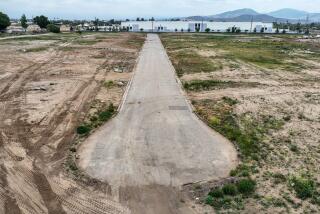Critics Attack Farmont Golf Course Report : Environment: An impact study says the club poses no threats to the Ojai Valley. Approval of the document is postponed.
Ojai Valley residents and environmental activists on Wednesday attacked an environmental report on a proposed golf course east of Ojai, saying it understated increases in air pollution, traffic and the potential for poisoning ground water with pesticides.
A parade of critics disagreed strongly with the environmental impact report that concluded that the proposed Farmont Golf Club poses no significant harm to the Ojai Valley’s environment. A Japanese broadcasting tycoon has proposed building the private club on a 200-acre parcel next to the Rancho Matilija subdivision.
“A good deal of this EIR is an insult to the intelligence of most Ojai Valley residents,” said Alisdair Coyne, an Ojai resident and an environmental activist who opposes the Farmont proposal. “It needs to be thoroughly revised and recirculated.”
Members of the Ventura County Environmental Report Review Committee, who held the public hearing Wednesday, decided to postpone approval of the report because of the volume of written and oral comments submitted. Committee members voted to reconsider the document on July 29 to give Planning Commission staff more time to analyze the new information.
Steve Craig, an environmental consultant working for the Farmont Corp., told the committee that the document properly examined the potential for environmental harm.
He said the critics were attacking the project itself, not the thoroughness of the study, and suggested that their complaints were better suited for the debate before the Ventura County Planning Commission on the merits of the project.
One of the central criticisms of the report concerned its suggestions for controlling traffic on the heavily traveled Maricopa Highway. Among other ideas, the report would have officials require golfers and employees to take back roads to Ojai or ride to the course in van pools as a way to curtail traffic during peak hours.
Coyne said the report also failed to adequately analyze the extent to which fertilizers, herbicides and fungicides could contaminate area soils and ground water.
Ojai resident Allen Carrozza reiterated Coyne’s complaints on potential pollution. “Building a golf course is the creation of an illusion of a garden,” Carrozza said, “and will lead to the leaching of chemicals into the ground water.”
Craig disputed the contentions of a pollution threat. He said Farmont plans to install a state-of-the-art maintenance system that would prevent contaminated runoff.
Pat Baggerly of the Ventura County Environmental Coalition questioned whether county zoning regulations allowed the 19,890-square-foot clubhouse that is proposed for the course.
“The environmental coalition thinks this is too large of a building to suit the uses of this golf course,” she said. She said Farmont officials have promised that the course will be played by a maximum of 35 golfers each day.
Baggerly also expressed concerns over the golf course’s hooking into the local sewer system because it could lead to more development in the area.
In written comments submitted earlier this month, the city of Ojai also raised the growth issue.
City officials asked that the environmental report include a binding agreement that Farmont will donate development rights to 1,400 acres of scenic mountainside property to the Ojai Valley Land Conservancy, as the corporation has proposed.
They also sought to prevent Farmont officials from developing 160 acres located within the Rancho Matilija subdivision that would not be part of the donation to the conservancy.
If such an agreement cannot be reached, the city asked that Farmont officials pledge to abide by the Rancho Matilija development rules, which allow only one home on each 40-acre parcel.
Much of Wednesday’s public hearing focused on an ongoing water dispute between Farmont officials and several local water agencies.
The Farmont Corp. has diversion rights to 1,900 acre-feet annually of Ventura River water, although very little of that is used for the citrus orchard and cattle ranching activities on the property.
Noting a Farmont pledge to limit water use to 407 acre-feet a year, the environmental report concluded that the course would not overdraw local water supplies.
But some water agencies have said 407 acre-feet would be much more than has been used recently on the property and could infringe on their ability to provide water to other customers in times of drought.
NEXT STEP
On July 29, the Ventura County Environmental Report Review Committee is scheduled to hold a second hearing on the adequacy of the environmental report for the proposed Farmont Golf Club. On July 22, county staff will release responses to written and oral comments submitted at Wednesday’s hearing. Public comments at the second hearing will be limited to recently submitted material.
More to Read
Sign up for Essential California
The most important California stories and recommendations in your inbox every morning.
You may occasionally receive promotional content from the Los Angeles Times.










